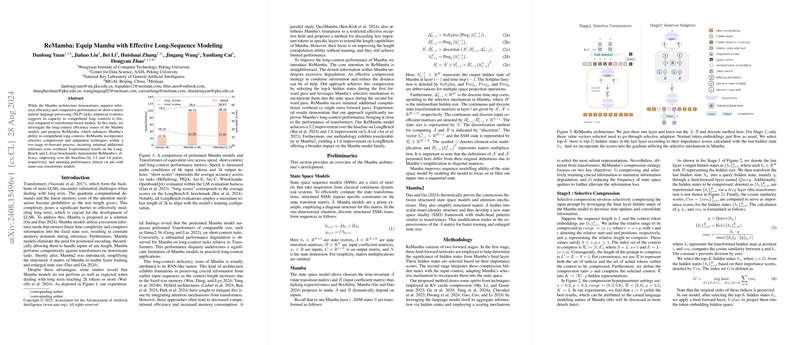ReMamba: Equip Mamba with Effective Long-Sequence Modeling
The paper presented discusses enhancements to the Mamba architecture, specifically targeting its limitations in handling long-context sequences. Named "ReMamba," the proposed model introduces a two-stage selective compression and adaptation mechanism to address Mamba's shortcomings in long-sequence modeling without incurring significant computational overhead.
Introduction
The Mamba architecture offers superior inference efficiency and competitive performance for short-context NLP tasks. However, empirical evidence has shown that Mamba's capacity to handle long contexts is limited compared to transformer-based models. To this end, the authors propose ReMamba to enhance Mamba’s ability to comprehend long contexts. ReMamba incorporates selective compression and adaptation techniques within a two-stage re-forward process, ensuring minimal additional inference costs.
State Space Models and Mamba
The authors begin by discussing state space sequence models (SSMs) which serve as the foundation for Mamba models. SSMs are inspired by continuous dynamical systems that impose specific constraints on the state transition matrix for efficient computation. Mamba advances this by dynamically allowing and to depend on input sequences, which theoretically eliminates the need for positional encoding and provides constant memory usage during inference. Despite these theoretical advantages, Mamba exhibits performance degradation with long-context sequences.
ReMamba Methodology
Stage 1: Selective Compression
The primary innovation of ReMamba lies in its selective compression mechanism. During the first forward pass, hidden states from Mamba’s final layer are evaluated based on their importance scores, calculated using a feed-forward network. Specifically, distances between these hidden states and a transformed version of the final hidden state serve as a measure of their importance. The top- hidden states, those with the highest importance scores, are selected and transformed back into the input token space for the subsequent forward pass.
Stage 2: Selective Adaption
In the second forward pass, the compressed hidden states are integrated into the Mamba model’s selective mechanism. This involves a modification where the importance scores influence the softmax operations governing state updates. This design aims to mitigate potential information loss commonly seen in recurrent architectures under extensive context lengths.
Experimental Results
The efficacy of ReMamba was validated through experiments on the LongBench and L-Eval benchmarks. The findings suggest that ReMamba outperforms the baseline Mamba models significantly on long-context tasks, achieving improvements of 3.2 and 1.6 points on LongBench and L-Eval respectively. Importantly, ReMamba's performance is nearly on par with same-size transformer models, a notable achievement considering transformers' quadratic computational demands on long texts.
Comparative Evaluation
The authors also compared ReMamba's performance against traditional transformers like LLaMA2-3B. Remarkably, ReMamba not only closed the performance gap but also maintained a substantial efficiency in computational resources compared to transformers. Additional evaluations demonstrated that ReMamba remains robust under varying lengths of the input context, with performance peaking at a 6k token length. Moreover, speed performance tests revealed that ReMamba's enhanced architecture did not impose a significant computational burden when compared to its baseline counterpart.
Generalization to Mamba2
ReMamba's design was further extended to Mamba2 architecture, demonstrating its broader applicability across the Mamba model family. Similar performance improvements were observed, underscoring the adaptability and efficacy of ReMamba's selective compression and adaption mechanisms.
Implications and Future Directions
Practically, ReMamba addresses a critical barrier in the application of Mamba models to long-context tasks, such as document summarization, question answering, and long-form text generation. Theoretically, the integration of importance-score-based selective mechanisms offers a promising direction for future research in RNN-like architectures, particularly for long-context sequence modeling.
The paper opens avenues for further refinement and optimization, potentially exploring more sophisticated compression techniques or multi-stage selective adaptations to further enhance model performance. Additionally, the concepts underlying ReMamba may be extended to other recurrent architectures facing similar long-context challenges.
In conclusion, the ReMamba model demonstrates a significant stride in overcoming the limitations of the Mamba architecture for long-sequence modeling, offering valuable insights and methodologies that may benefit a broad spectrum of long-context NLP applications.
